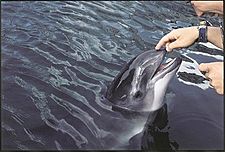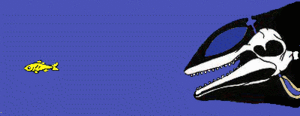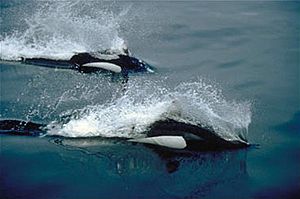Porpoise facts for kids
Quick facts for kids PorpoisesTemporal range: Mid Miocene to Recent
|
|
|---|---|
 |
|
| Phocoena phocoena, Harbour porpoise at the Fjord & Bæltcentret in Denmark | |
| Scientific classification | |
| Kingdom: | |
| Phylum: | |
| Class: | |
| Order: | |
| Suborder: | |
| Family: |
Phocoenidae
Gray, 1825
|
Porpoises are amazing marine mammals that live entirely in the water. They belong to a group called Phocoenidae, which is part of the toothed whale family. There are seven different kinds of porpoises living today.
These small toothed whales are very similar to oceanic dolphins. The easiest way to tell them apart is by their teeth. Porpoises have shorter snouts and flat, spade-shaped teeth. Dolphins, on the other hand, have cone-shaped teeth. Porpoises are also related to hippopotamuses, but they split off from them about 40 million years ago.
Porpoises come in different sizes. The vaquita is the smallest, about 1.4 metres (4.6 ft) long and weighing 54 kilograms (119 lb). The largest is the Dall's porpoise, which can be 2.3 metres (7.5 ft) long and weigh 220 kilograms (490 lb). Female porpoises are often a bit bigger than males. They have smooth, torpedo-shaped bodies and flippers instead of front legs.
Dall's porpoise is one of the fastest whales, able to swim at 41 knots (76 km/h). Porpoises use echolocation to find their way around and hunt. This is like using sound waves to "see." They have a layer of fat called blubber under their skin. This blubber helps them stay warm in cold ocean waters.
Porpoises are not found everywhere. Many prefer colder, polar regions, often staying close to the coast. They mostly eat fish and squid, just like other toothed whales. Males usually mate with many females each year. However, females only mate every two to three years. Babies, called calves, are usually born in spring or summer. The mother takes care of the calf all by herself. Some porpoises make clicks and whistles. These sounds are thought to be for talking to each other. Some species, like the harbour porpoise, are very social. But most porpoise groups, called pods, usually have fewer than ten members.
Sadly, porpoises have been hunted in some parts of the world. Some species are very smart. Scientists have even suggested that whales and dolphins should have special rights, like non-human persons. The vaquita is in great danger of disappearing forever. With fewer than 100 left, it is the most endangered whale or dolphin. Other dangers to porpoises include getting caught accidentally in fishing nets. They also face competition for food and pollution in the ocean. Sometimes, porpoises are kept in aquariums. But it has been hard for them to have babies in captivity.
Contents
Porpoise Family Tree
Porpoises, along with whales and dolphins, came from land animals with hooves. These ancestors first went into the ocean about 50 million years ago. During the Miocene period (23 to 5 million years ago), many mammals were already quite modern. Porpoises and dolphins split from their last shared ancestor about 15 million years ago. The oldest porpoise fossils have been found in the shallow seas of the North Pacific. Later, during the Pliocene period, they spread to European coasts and the Southern Hemisphere.
Porpoise Body and Movement
Body Features
Porpoises have a rounded head and no outside ear flaps. Their neck is not very flexible. They have a torpedo-shaped body and flippers instead of front legs. They also have a tail fin. Their skull has small eye sockets and a short, blunt snout. Their eyes are on the sides of their head.
Porpoises are generally smaller than other whales and dolphins. Most species have females that are larger than males. However, these size differences are usually small. The Dall's porpoise is an exception, where the size difference can be more noticeable.
Porpoises have teeth with special cells called cementum. Unlike human teeth, which have enamel on the outside, whale teeth have cementum. Like other toothed whales, porpoises have only one blowhole. When they breathe, they push out old air from their blowhole. This creates a steamy spout. Then they breathe in fresh air. All porpoises have a thick layer of blubber. This blubber helps them stay warm in cold water. It also offers some protection from predators. And it stores energy for times when food is scarce. Baby porpoises are born with thin blubber. Some species have fine, downy hair called lanugo to help keep them warm.
How Porpoises Move
Porpoises have two flippers at the front and a tail fin. They do not have fully developed back legs. However, they do have small, hidden parts that might have feet and toes. Their flippers have four "fingers" inside. Porpoises are fast swimmers. They are much faster than seals, which usually swim at 9–28 kph. A Dall's porpoise can swim up to 74 kilometres per hour (46 mph).
Their neck bones are fused together. This helps them swim fast but means they cannot turn their heads. When they swim, they move their tail fin and lower body up and down. This pushes them through the water. Their flippers are mostly used for steering. They move their flippers all the time. Some porpoises jump partly out of the water. This might help them swim faster. Sometimes they jump completely out of the water, which is called "porpoising." Their bones are built for fast swimming. They have a clear, triangular dorsal fin on their back. This helps them steer better. Unlike dolphins, porpoises are often found near coasts, bays, and river mouths.
Porpoise Senses

Porpoises have special ears for living in the ocean. In humans, the middle ear helps sound travel from the air to the inner ear. For porpoises, there is not much difference between the water outside and the water inside their bodies. Instead, sound travels through their throat. From there, it goes through a fat-filled space to the inner ear. Their ears are also separated from the skull by air pockets. This helps them hear sounds from different directions underwater.
Toothed whales, including porpoises, send out high-frequency clicks. They do this from an organ called a melon. This melon is made of fat. The porpoise's skull has a large dip where the melon sits. The big bump on top of a porpoise's head is caused by this melon.
A porpoise's eye is small for its body size. But they can still see quite well. Their eyes are on the sides of their head. This means they see two separate views, not one combined view like humans. When porpoises come to the surface, their eyes adjust. This corrects the blurry vision that happens when light bends in water. Their eyes have both rod and cone cells. This means they can see in both dim and bright light. However, porpoises might not see as many colors as most mammals. Most porpoises have slightly flat eyeballs and large pupils. These pupils shrink when they surface to protect their eyes. They also have a special reflective layer called a tapetum lucidum. These features help a lot of light enter the eye. This allows them to see clearly underwater.
Porpoises do not have olfactory lobes. This means they probably cannot smell anything.
Porpoises are not thought to have a good sense of taste. Their taste buds are either very small or missing. But some porpoises prefer certain types of fish. This suggests they might have some sense of taste.
How Porpoises Sleep
Unlike most animals, porpoises have to think about breathing. All mammals sleep, but porpoises cannot become fully unconscious for long. If they did, they might drown. We do not know much about how wild porpoises sleep. But porpoises in captivity have been seen sleeping with only one side of their brain at a time. This allows them to keep swimming and breathing. It also helps them avoid predators and stay aware of their surroundings while resting.
Porpoise Life and Habits
Life Cycle

Porpoises live their entire lives in the water. Female porpoises give birth to one baby after being pregnant for about a year. Birth happens completely underwater. The baby is born tail-first. This helps prevent it from drowning. Female porpoises have mammary glands, but the baby's mouth cannot latch onto the nipple. Instead, the mother squirts milk into the baby's mouth. This milk is very fatty, like toothpaste. This helps the baby grow its blubber layer quickly. Babies are usually weaned, or stop drinking milk, around 11 months old. Male porpoises do not help raise the babies. The baby porpoise depends on its mother for one to two years. They become adults after seven to ten years. This time varies between different porpoise species. This way of having few babies but taking good care of them helps more of them survive.
What Porpoises Eat
Porpoises eat many different kinds of food. Harbour porpoises mainly eat fish that live on the ocean floor. They sometimes eat fish that swim in the open water. They might also eat small creatures without backbones that live on the bottom. Very rarely, they might eat algae. Atlantic porpoises seem to follow the seasonal movements of small fish like herring. So their diet changes with the seasons.
Dall's porpoises mostly eat squid and small fish like capelin and sardines. Their stomachs have also shown some deep-sea creatures from the ocean floor.
Finless porpoises also move with the seasons. In the Indus River, some populations swim to the sea from April to October. They go there to eat prawns that are spawning. In Japan, it is common to see small groups of them herding sand lance fish onto the shore all year round.
We do not know much about what other porpoise species eat. One study of three Burmeister's porpoises showed they ate shrimp and krill. A dead Vaquita that washed ashore had squid and grunt fish remains in its stomach. We know nothing about the diet of the spectacled porpoise.
Dangers to Porpoises
Hunting
Porpoises and other small whales, especially dolphins, are hunted in a method called drive hunting. This involves boats herding a group of porpoises into a bay or onto a beach. Then, other boats or nets block their way back to the ocean. Porpoises are hunted this way in places like the Faroe Islands, Peru, and Japan. Japan is well-known for this method. Porpoises are mostly hunted for their meat. This type of hunting is very controversial and has been criticized internationally. The meat can also have high levels of mercury, which is dangerous to eat. Despite this, some cetaceans are hunted too much. Dall's porpoises are the most hunted in Japan. Between 1986 and 2013, over 400,000 Dall's porpoises were killed.
Fishing Dangers
Porpoises are often accidentally caught in fishing nets. This is called bycatch. Many porpoises, especially the vaquita, die because they get caught in gillnets. The vaquita is the most endangered marine mammal in the world. But it still gets caught in small-mesh gillnets in its home area. It was estimated that about 39 vaquitas died each year from fishing nets in one area. This was more than 17% of their total population. Harbour porpoises also drown in gillnets. But their population is much larger, so it is less of a threat to their survival.
Historically, porpoises have always been caught accidentally by fishing boats. Today, laws like the Marine Mammal Protection Act of 1972 have made fishing equipment safer. This helps reduce the number of porpoises caught by accident.
Images for kids
-
Harbour porpoise in captivity
-
Traditional catch of harbour porpoise by lancing in Bay of Fundy
See also
 In Spanish: Marsopas para niños
In Spanish: Marsopas para niños






